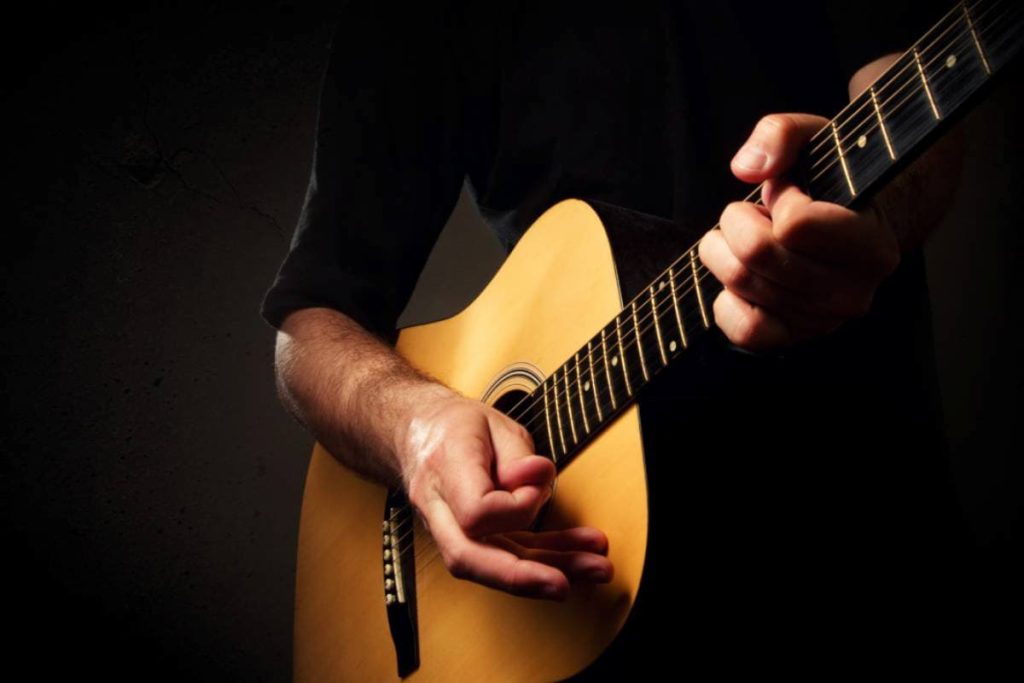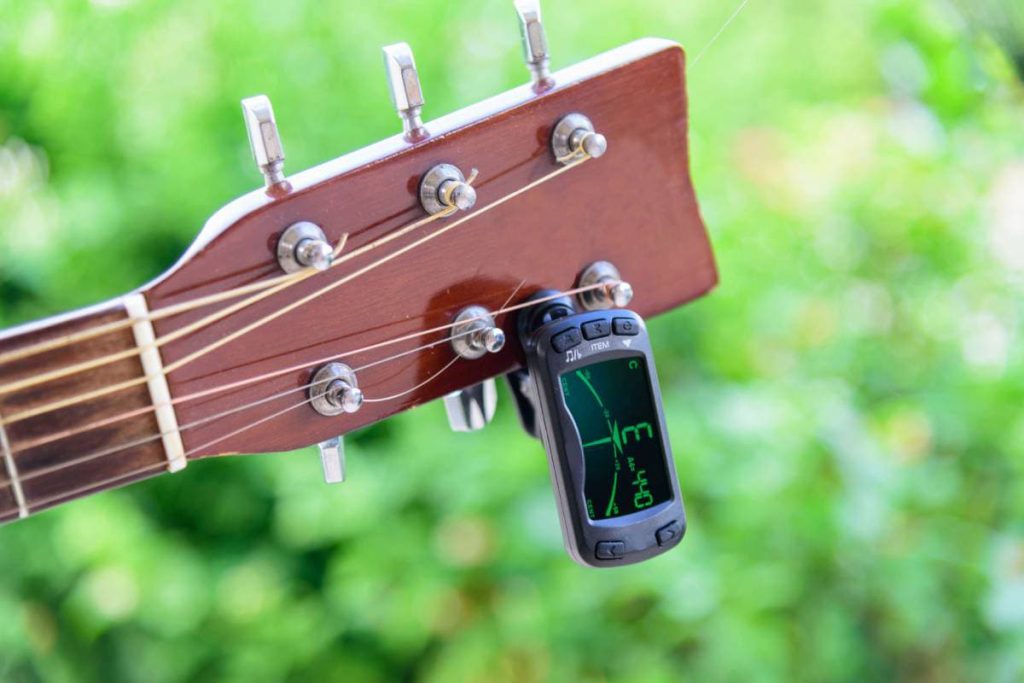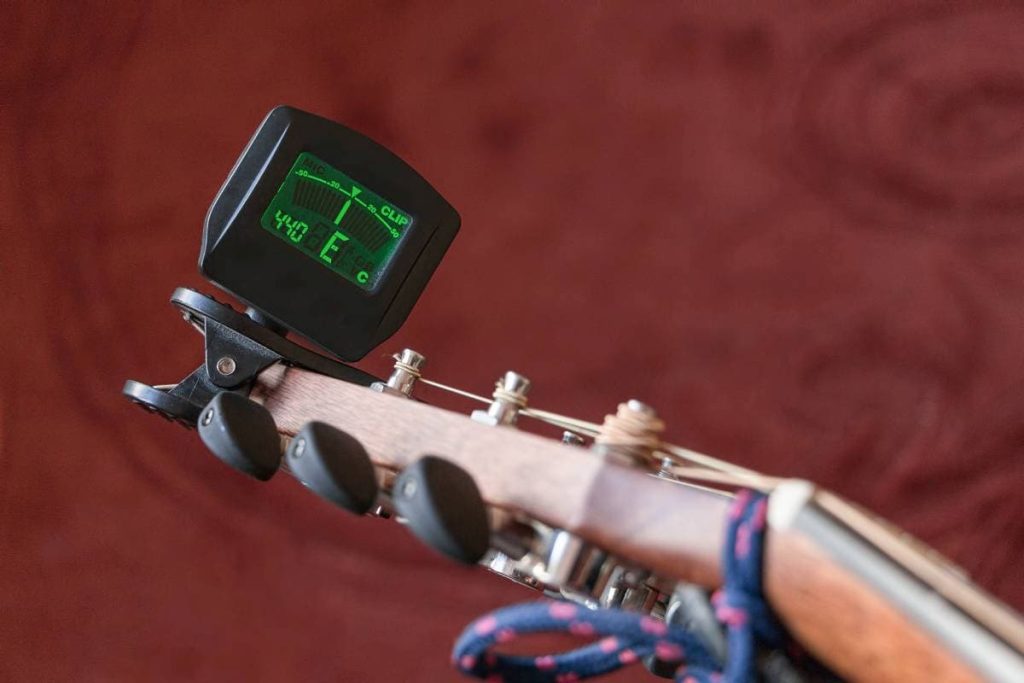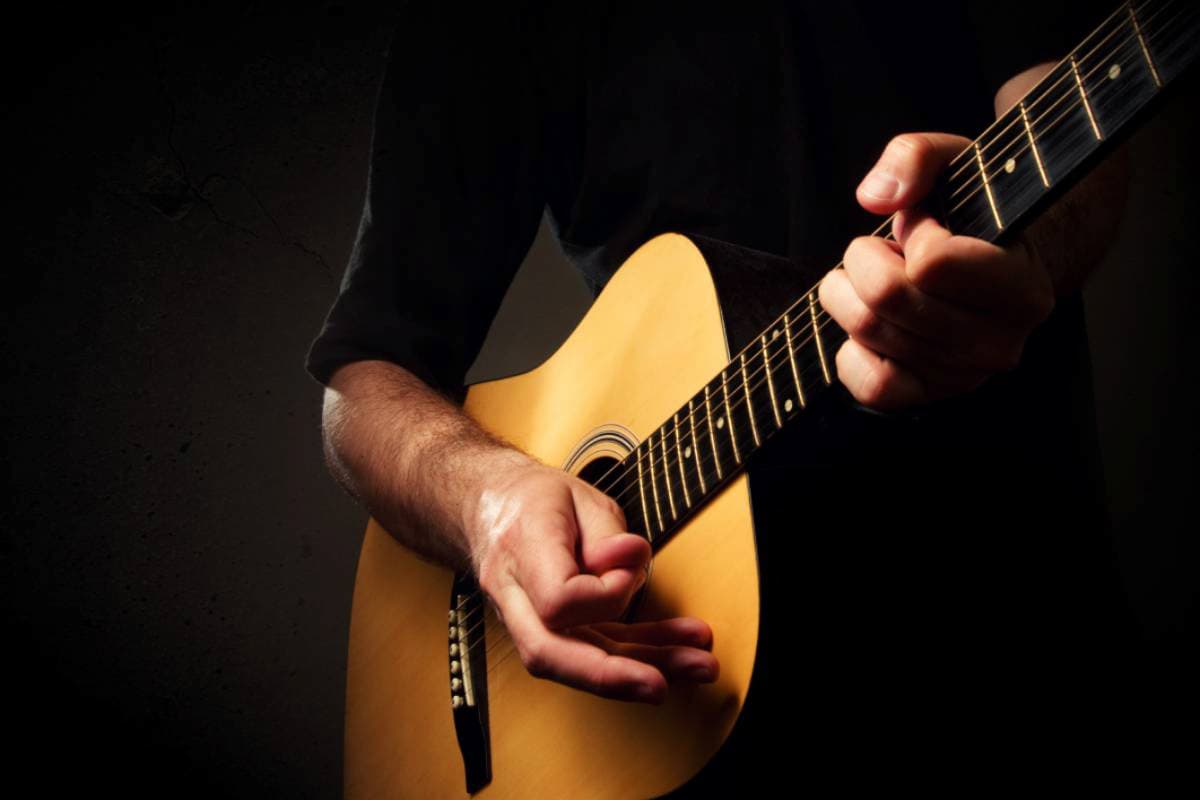Guitars go out of tune relatively easily, and an out-of-tune guitar can ruin a perfectly enjoyable jam session pretty quickly. Therefore, it’s important that you understand how to tell when a guitar is correctly tuned and when it is not so you can promptly adjust the turning knob and carry on playing.
Here are five ways to tell if your guitar is tuned correctly:
- Use a tuner app.
- Check your guitar’s tuning using natural harmonics.
- Play a familiar song and see if the notes sound correct.
- Use a guitar tuner.
- Check tuning with reference pitches.
Below, I’ll explain each of these approaches more in-depth. By the end of this read, you’ll have a clearer understanding of how to tell when your guitar is properly tuned and when it is not.
👇😀👇NOTE👇😀👇
If you want to find out what my recommended guitar gear is, then here is what I recommend on Amazon:
- Fender Cutaway Acoustic-Electric Guitar Bundle (MY FAVORITE GUITAR)
- Snark SN-8 Super Tight All Instrument Tuner (Easiest Tuner I’ve Used😏)
- 6 String Acoustic Guitar Capo (Best CAPO for quick changes)
- Dunlop Max Grip 1.0mm Nylon Picks (Thick Guitar Pick So You Don’t Lose Grip!)
- Universal Guitar Stand (Cheap & Minimalist Guitar Stand I Recommend)
- Levy’s 2″ Wide Quick Adjust Guitar Strap (Best Guitar Strap For Any Level)

1. Use a Tuner App
One way to check your guitar’s tuning is to use a tuning app. Tuning apps are a convenient way to check and see if your guitar is tuned correctly, as most people who have smartphones have them on their person almost all the time. Therefore, you most likely won’t find yourself in a situation where you need to check your guitar’s tuning, but don’t have a tuner with you.
Tuner apps use the microphone on a smartphone to hear the guitar and determine whether the string is in tune or not. This is a relatively accurate way to check a guitar’s tuning, but the microphone may pick up external noises, influencing the reading.
This is likely not going to be an issue if you’re home alone or in a relatively quiet environment; however, if you’re in a busy public area, it may be difficult to get an accurate idea of whether your guitar is tuned correctly.
There are two kinds of smartphone app tuners: one kind (which I used as an example above) uses the microphone to listen to the guitar and help you get it in tune, while the second provides a reference note that helps you determine if your guitar is tuned.
Many of the apps work the same way. In general, here’s how you use a smartphone tuner app:
- Choose which tone you want for the first string and tap the corresponding string or button on your phone to start playing the note, then play the string on your guitar.
- Hold your phone as close to the guitar as possible to get the most accurate reading.
- Turn the tuner knob to try and match the pitch of your guitar to the tone playing on the app.
- Many apps will indicate if your guitar’s tone is too high or low – this helps you determine how to adjust your tuner knob.
- Once your string matches the pitch of the corresponding string on the app, that string is tuned.
- Repeat the process with all the remaining strings.
When you’re trying to decide which tuner app to use, there are some features you should look out for, including:
- A clear, easy-to-read display. It shouldn’t take too long for you to check if your guitar is tuned correctly, and if you’re using a tuner app with an overly-complicated display, the process could take longer than it should. The best apps have a simple display that shows you the pitch and how flat or sharp the sound is, allowing you to quickly adjust as necessary.
- Multiple tunings. Most players use standard guitar tunings; however, advanced musicians like to use a more complex approach, and the best apps can show you how to tune your strings according to these variations.
- Ability to tune multiple instruments. The best tuner apps can help you tune more than just your guitar. Many guitar players play other stringed instruments, such as a ukulele or banjo, and your app should help you tune these instruments as well.
The following table outlines some of the most popular tuner apps you can use to check and see if your guitar is tuned correctly:
| Name of App, Cost, and Compatibility | Pros | Cons |
| Fender Tune Free, but the Pro version is $4.99 Compatible with iOS and Android | Auto and manual tuning settingsGood for beginners because of the Tips featureEasy to use | Extremely sensitive to noise, so if there’s any background noise at all, the app may not workRequires the Fender Slide to plug your guitar into the phone, which is an expensive accessory |
| Guitar Tuna Free, with various in-app purchases available Compatible with iOS and Android | Auto and manual tuning settingsComes with chord learning games, a metronome, a chord library, pitch calibration, and a songbookCan be used to tune other stringed instruments, including bass, ukulele, and banjoEasy to useAccurate | Some features require in-app purchases |
| gStrings Free Only compatible with Android | Screen display is big, so this is a good app for people with visibility issuesEasy to navigateAbility to adjust microphone sensitivityOption to tune by earOffers the ability to tune non-stringed instruments | The app can be a bit slow to register sound Not compatible with iPhones and iWatches |
| BOSS Tuner Free Only compatible with iOS | Uses chromatic tuningNo in-app purchasesAbility to tune non-stringed instrumentsLED segment meter that acts as a visual indicatorPlays reference pitches continually until you inform the app to stopNo pop-up ads | Not compatible with AndroidToo many notification alerts |
| Pano Tuner Free, paid option available Compatible with iOS and Android | Quick responseChromatic tunerCan tune any instrumentCustomizable settings where you can choose to view the notes as letters or as Do Re Mi | This app is only a tuner; there are no extra featuresLots of pop-up ads |
| Pitched Tuner Free, Pro option available for $3.99 Compatible with iOS | Ability to customize the interface style, volume sensitivity, and note nameSleek displaySimple interfaceEasy to use | Requires in-app purchase to remove ads and get custom tunings |
Using a tuner app is an excellent, convenient way to check if your guitar is tuned correctly, but it isn’t your only option.

2. Check Your Guitar’s Tuning Using Natural Harmonics
Harmonics make a unique bell sound on a guitar, and you can use these sounds to check if your guitar is tuned correctly. The easiest harmonics to play are above the fifth, seventh, and twelfth frets.
Before you can start using harmonics to check your guitar’s tuning, you must know how to play them. Here’s how:
- Place your finger on the sixth string above the twelfth fret.
- Lightly press the string.
- Use your right hand to pluck the sixth string.
- Immediately remove your finger from the string after you’ve plucked it.
- You should hear a chime-like sound.
It may take some practice to master this technique. This video may help you if you’re struggling:
Once you know how to play harmonics, you can use this technique to check if your guitar is in tune. To start, your sixth string should be tuned to E, if you’re using standard tuning. You’ll be using this string as a reference, so if it isn’t in tune, the rest of your guitar won’t be in tune either. For this reason, you should train your ear to recognize E as soon as possible.
The following harmonics should make the same chiming sound if the guitar is tuned correctly:
- The harmonic on the fifth fret of the sixth string and the harmonic on the seventh fret of the fifth string.
- The harmonic on the fifth fret of the fifth string and the harmonic on the seventh fret of the fourth string.
- The harmonic on the fifth fret of the fourth string and the harmonic on the seventh fret of the third string.
- The harmonic on the seventh fret of the sixth string and the open second string (not a harmonic, just the second string by itself).
- The harmonic on the fifth fret of the second string and the harmonic on the seventh fret on the first string.
Once those harmonics match, then your guitar is tuned correctly. This may seem like an overwhelming and complicated process, but with practice, it’s a great way to check a guitar’s tuning because you don’t need any external tools.

3. Play a Familiar Song and See if the Notes Sound Correct
If you’ve been playing guitar for a while and trust your ear, you can play a song that you know well and use your intuition to check if the guitar is tuned correctly or not. Many popular songs are played in standard tuning, so you can play one of these songs to see if it sounds right.
If you start playing a song and it sounds a little off, there’s a good chance that your guitar isn’t tuned correctly.
Here are some of the most popular and well-known songs that use standard tuning:
- Hallelujah by Jeff Buckley
- All of Me by John Legend
- Can’t Help Falling in Love by Elvis Presley
- Stairway to Heaven by Led Zeppelin
- I’m Yours by Jason Mraz
- The Scientist by Coldplay
- Wonderwall by Oasis
- Someone Like You by Adele
- Hey Jude by the Beatles
- Fast Car by Tracy Chapman
- Landslide by Fleetwood Mac
- Wagon Wheel by Darius Rucker
- Love Story by Taylor Swift
It may take some practice for you to develop your ear and be able to tell when your guitar is out of tune without using a tuner, but trying this approach with songs you know well is a good place to start.
4. Use a Guitar Tuner
One of the most accurate ways to check if your guitar is tuned correctly is to use an instrument tuner. Guitar tuners are devices that use the frequencies produced by vibrating strings and align those frequencies with notes on the musical scale. Then, the tuner displays that note. The two main tuners for guitars are pedal tuners and clip-on tuners.

Tuner pedals work by plugging a guitar to the pedal with an instrument cable. Then, the pedal can identify the electrical signal and display the pitch on the pedal. This is an extremely accurate way to check a guitar’s tuning because there isn’t any interference from external sounds that influence the tuner’s pitch display. These tuners are for electric or electric-acoustic guitars.
My favorite pedal tuner is the Boss TU-3 Chromatic Tuner, available on Amazon.com. This tuner is an especially great choice for players who play a lot of outside gigs, as the pedal has a glare-free and high brightness mode, which accommodates for reduced visibility in outdoor conditions. There’s also an Accu-Pitch Sign function, which provides visual verification when the guitar is tuned correctly.
Another one of my all-time favorites is the TC Electronic POLYTUNE 3 Tuner from Amazon.com. This affordable pedal tuner works just as well as more expensive models, and it is extremely accurate. You can choose from three different modes: polyphonic, chromatic, and strobe. I also like how compact it is, so it can easily fit into a small pocket, but the display is still incredibly easy to see.
Clip-on tuners attach to a guitar’s headstock and then measure the vibrations in the guitar’s wood. These tuners are excellent because they work with every type of guitar, including acoustic guitars, not to mention they’re easy to use and reliable.
To use a clip-on tuner:
- Attach it to the headstock of your guitar and adjust it so you can see the display.
- Play the sixth string and see what the tuner says the note is.
- Adjust the tuning knob until you reach the note you want the sixth string to be. If you’re tuning to standard, the sixth string should be E.
The following video demonstrates this process in more detail:
I recommend using the Snark ST-8 Super Tight Clip-On, which you can get on Amazon.com. This tuner has a bright, high-definition display, making it easy to see without straining or struggling. Furthermore, the 360-degree swivel head helps you check the tuning of your guitar at any angle. Finally, the affordable price tag drives up this tuner’s value exponentially, while its portability adds that extra bit of convenience that I’m always looking for.
Another great option you can get on Amazon.com is the D’Addario Guitar Tuner. This tuner is incredibly small and low-key, reasonably priced, and easy to keep on your guitar, even permanently, if you’d like. I love the fact that the screen can rotate so you can always see what’s going on, and it has various calibration modes and a sensitive and quick response. This tuner also works with any stringed instrument, so you’ll get a lot of use out of it.
5. Check Tuning With Reference Pitches
Finally, another simple way to check your guitar’s tuning is to check if its sound matches various reference pitches. All you need to do is play the pitches that the strings on your guitar are supposed to match and use your ears to determine whether your guitar is in tune or a little off.
If you aren’t used to listening to pitches, this may take some practice, but once you master the technique, you can get your guitar tuned correctly quickly and stress-free. You can also save the reference pitches on your phone as mp3 files to always have access to them. Alternatively, most tuner apps include reference notes as well.

The following table outlines which note your strings should be tuned to in standard tuning:
| String | Note |
| Sixth (thickest) | E |
| Fifth | A |
| Fourth | D |
| Third | G |
| Second | B |
| First (thinnest) | E |
However, you don’t always have to use standard tuning. In fact, using alternate tuning can help you create all sorts of interesting and unique sounds. Here are some common alternative tunings:
Drop D
Drop D is commonly used in rock and metal music, and it’s relatively easy to switch to this tuning from standard. If your guitar is in standard tuning, you need to lower the E string down one step to D. Then, you’ll get a deeper and more resonant sound, which allows for more sophisticated power chords.
The following table outlines how to get this tuning:
| String | Note |
| Sixth (thickest) | D |
| Fifth | A |
| Fourth | D |
| Third | G |
| Second | B |
| First (thinnest) | E |
DADGAD
This tuning is widely used among masters of fingerstyle acoustic guitar. This tuning allows for more open-string drones and same-fret octave shapes. Here’s how to accomplish this tuning:
| String | Note |
| Sixth (thickest) | D |
| Fifth | A |
| Fourth | D |
| Third | G |
| Second | A |
| First (thinnest) | D |
Open D
Another option is Open D. This type of tuning relaxes the string’s tension and creates an interval stack of a root-fifth octave power chord on the bottom three strings and a first-inversion major triad on the top three strings. It is easier to play slides on an acoustic guitar in this tuning, which is why it’s commonly used by blues musicians. Here’s how to achieve this type of tuning:
| String | Note |
| Sixth (thickest) | D |
| Fifth | A |
| Fourth | D |
| Third | F# |
| Second | A |
| First (thinnest) | D |
The more you use reference notes to check your guitar’s tuning, the easier it will be for you to tune by ear. Eventually, it will become a quick, mindless process that is simply part of you picking up and playing your guitar.
👇😀👇NOTE👇😀👇
If you want to find out what my recommended guitar gear is, then here is what I recommend on Amazon:
- Fender Cutaway Acoustic-Electric Guitar Bundle (MY FAVORITE GUITAR)
- Snark SN-8 Super Tight All Instrument Tuner (Easiest Tuner I’ve Used😏)
- 6 String Acoustic Guitar Capo (Best CAPO for quick changes)
- Dunlop Max Grip 1.0mm Nylon Picks (Thick Guitar Pick So You Don’t Lose Grip!)
- Universal Guitar Stand (Cheap & Minimalist Guitar Stand I Recommend)
- Levy’s 2″ Wide Quick Adjust Guitar Strap (Best Guitar Strap For Any Level)
Related Posts:

